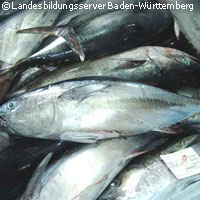Overfishing led to demise of northern Europe's tuna population, study shows
A new study has revealed how overfishing in the first half of the 20th century decimated northern Europe's bluefin tuna population. Once abundant throughout the region's seas, by the 1960s the species had virtually disappeared and it remains rare to this day. The work was partly funded by the EU and is a contribution to the Census of Marine Life, an international initiative to assess and explain the abundance and diversity of life in our oceans in the past, present and future. North Atlantic bluefin tuna, Thunnus thynnus, used to migrate in large numbers to northern European waters during the summer months to feed on herring, mackerel and squid and other fish. Writing in the journal Fisheries Research, Brian MacKenzie of the Technical University of Denmark and the late Ransom Myers of Dalhousie University in Canada track the development of the north European tuna fishery during the first half of the last century. They gathered data from a range of sources, including the statistical bulletins of the International Council for the Exploration of the Sea, as well as national fishery yearbooks, fishing industry newspapers and reports, historical accounts and scientific literature. Until the early years of the 20th century, tuna was only ever caught accidentally by fishermen targeting other species. However, all that changed when fishermen realised that the tuna had significant market value. Soon new and improved ways of catching the large fish had been developed. These included harpoon rifles, improved hook and line methods and hydraulically operated purse seine nets. At the same time, more and more fishermen focussed their efforts on tuna, and canneries sprung up across the region to process the growing catch. The most important countries involved in the bluefin tuna fishery in this period were Norway, Denmark and Sweden, but the UK, France, Germany and the Netherlands also exploited the fish. Sport fishermen also became interested in the tuna, and until the 1960s the Scandinavian Tuna Club held bluefin tournaments in the straits between Denmark and Sweden. The result of this huge increase in fishing effort was a sharp rise in landings and by the 1940s the catch levels were similar to those found in Mediterranean fisheries today. In the early 1950s, Norwegian catches alone topped 10,000 tonnes per year. However, by the 1960s the fish had virtually disappeared from the region and it is still extremely rare. 'We can't say with certainty that over-exploitation is the smoking gun in the bluefin tuna's disappearance - but clearly there's been a murder,' commented Dr MacKenzie. 'We've shown bluefin tuna were here for a long time in high numbers. High fishing pressure preceded the species' virtual disappearance from the area and apparently played a key role but other factors under study might have compounded the fishery's demise - the catch of juvenile tuna in subsequent years, for example.' Studies of this kind, which investigate the population level before the start of commercial exploitation, are important for our understanding of the population biology of commercial fish species. 'This study has established that bluefin tuna was abundant in the early decades of the 1900s in northern Europe. However the species has been rare in this area since the 1970s,' the scientists conclude in their article. 'Given that preserving the spatial range of exploited populations is a key for long-term sustainability, the management of bluefin tuna in the Atlantic requires a more precautionary approach, with more concern about re-establishing and maintaining the historical range of the species.' EU funding for the project came from the Sixth Framework Programme MarBEF (Marine Biodiversity and Ecosystem Functioning) project.



